San Diego is a paradise for nature lovers, with its picturesque landscapes and diverse wildlife. One of the most interesting aspects of it is the rich variety of mushrooms that grow in and around the city.
From the edible varieties to the brightly colored fungi, there is something for everyone when it comes to identifying and collecting mushrooms in San Diego. Not only do they make an exquisite addition to a meal or provide aesthetic appeal, but they also have a wealth of health benefits.
Common San Diego mushrooms include liver boletes, sulphur shelfs, puffballs, inky and honeys.
List of Edible Mushrooms in San Diego
It is important to be cautious when identifying and consuming wild mushrooms, as some species can be poisonous. If you are unsure whether a mushroom is safe to eat, it is best to err on the side of caution and not consume it.
1. Blushing Morel
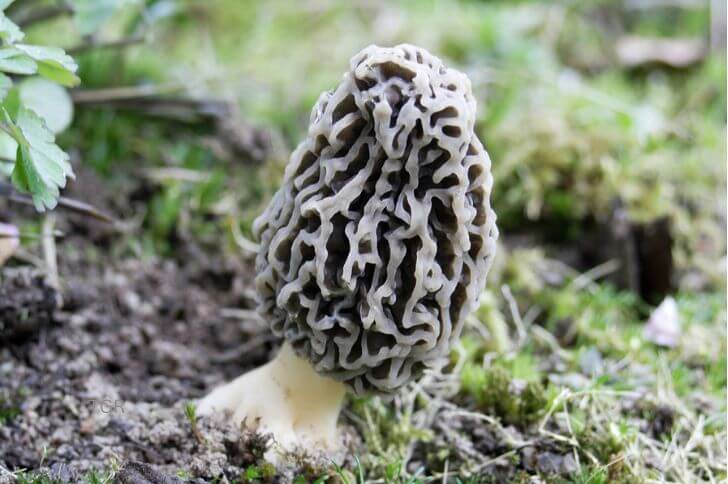
Blushing morel mushrooms are a favorite of both amateur and professional foragers, who hunt them as a tasty addition to any meal. Understanding what they look like gives you a better chance at spotting them while foraging.
Identification:
Like other morel species, they are a warm and damp weather type of mushroom. The best time to hunt or forage for them in San Diego is January through May.
Blushing morels also known as wood chip morels are common in mulched areas. Its fruiting body is tall, standing at about 8.3 inches when mature. Like other true morels, this San Diego fungi has a canonical cap that is covered with ridges and veins that form pits, giving it a honeycomb look.
Young species have dark grey caps that turn buff with age. The stipes are equally long with enlarged bases. Additionally, true morels will have hollow stems while false ones will be solid all the way through when cut open lengthwise.
Are blushing morels edible? Yes, wood chip morels are edible. We recommend you saute in garlic and butter.
2. Western Sulphur Shelf
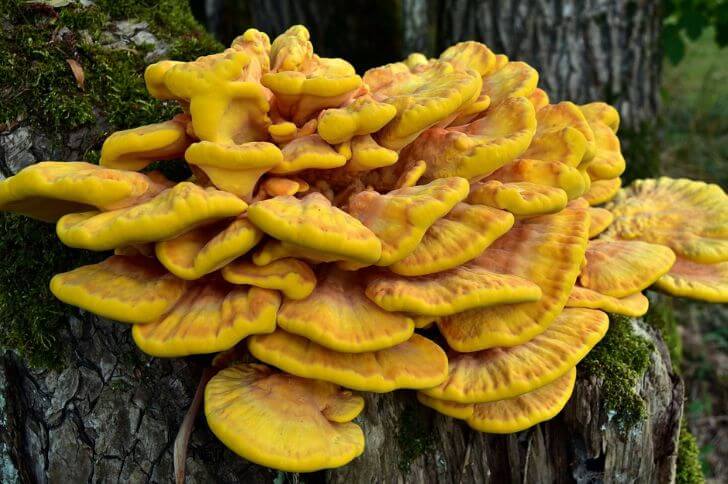
Sulphur shelf mushrooms are common in North America. On the western side of the country the western sulphur shelf is the most common variety. Its scientific name is laetiporus gilbertsonii.
Identification:
Like other shelf fungi they are commonly found on living trees, mainly eucalyptus and oaks. You’ll find them growing on the base of these trees.
Young bodies are orangish yellow and spongy. When cut, its flesh is yellowish and sometimes white. As they mature, these shelf mushrooms turn light brown and have a woody texture. We recommend you harvest them when young.
Western sulphur shelf mushrooms are common from late summer through fall. Cook thoroughly before consumption.
3. Honey Mushrooms
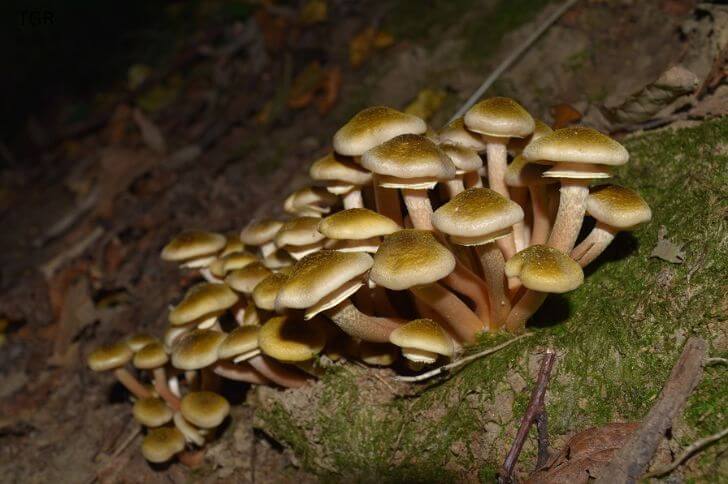
Heavy rains come with some of the best fungi in San Diego, honey mushrooms. Armillaria mellea is parasitic, often found on stumps, fallen branches and dead roots.
Identification:
With their unique color and flavor, they are a popular choice for adding to many dishes. Honey mushrooms have a spongy stem when young and it becomes hollow as it ages. Stems are whitish at the top, yellowish-brown in the middle and dark on the base. They are also covered with hair.
As for the caps they are usually yellowish-brown in color as well. They often have a convex shape when fully grown with a smooth surface that is somewhat sticky when touched. When cut open, honey mushrooms will reveal white flesh which is firm.
Can you eat honey? You can have them sauteed, roasted, or in soups.
4. Western Giant Puffball
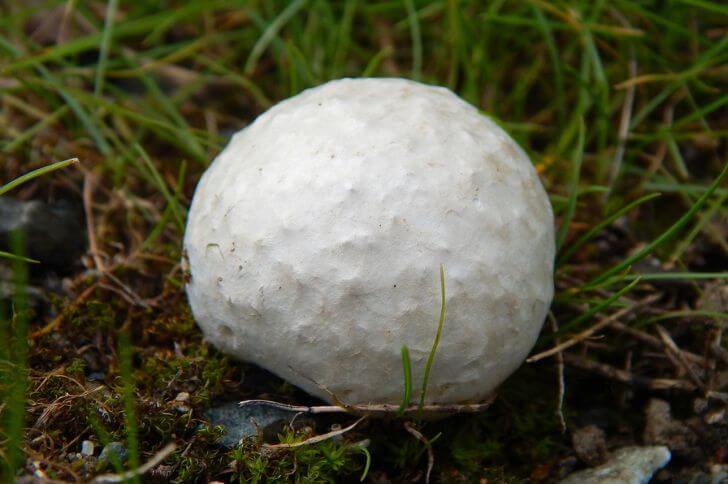
Another large spring mushroom of San Diego you should be on the lookout for is the western giant puffball. Preferring near-desert conditions, these white San Diego mushrooms are very distinctive.
Identification:
Identifying a Western giant puffball can be an exciting experience for mushroom hunters in North America. The species, also known as Calvatia booniana, is one of the largest terrestrial fruiting bodies of any fungus and grows to an average of 1-2.5 feet in diameter.
When trying to identify a Western giant puffball, there are several key characteristics that can be used as indicators.
It’s usually round-shaped with no indication of ribs or stalks; its surface appears smooth and white when young but changes to brownish and rough as the mushroom matures. Inside, the flesh should be dense and white without any internal chambers or structure visible.
5. Golden Milkcap
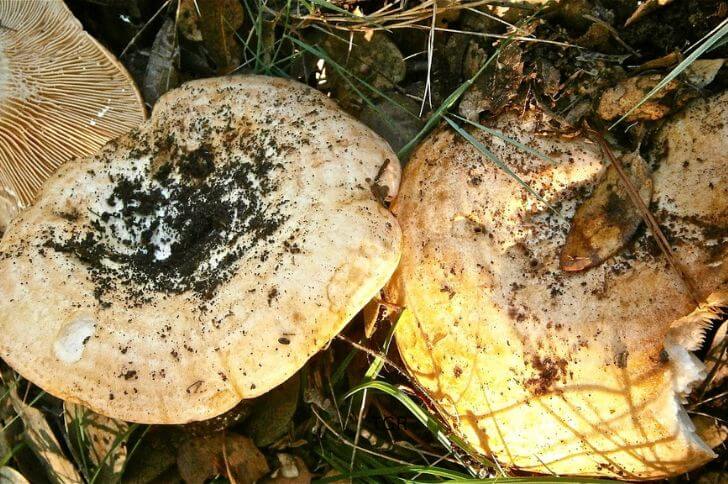
Golden Milkcap mushrooms are an edible fungi prized for their color, flavor, and texture. Foraging for these mushrooms requires knowledge of the differences between Golden Milkcaps and other inedible varieties.
Identification:
The most striking characteristic of this mushroom is its golden-orange coloration. When young, it has a convex cap that’ll eventually flatten out in maturity. Surface can be sticky. On the underside, these milkcaps have slightly decurrent crowded gills. When cut, they produce a milk-like liquid that turns yellowish after some time.
The flesh is thick and firm. Its stem is solid, not hollow like some other mushroom varieties, and often has a thick base. In addition to its unique coloring, Golden Milkcaps have an unmistakable hot and bitter taste.
6. Oak-loving Bolete
If you love mushrooms, the Oak loving bolete is one to add to your list. It’s a type of mushroom that grows on oak trees, and can be identified by its unique cap and stem.
Identification:
The cap of this mushroom is reddish-brown in color and generally convex in shape. Cap underside has small lemon yellow pores that bruise faint blue.
The stem is club-shaped and is usually lemon yellow in color; it can also have darker tones near its base due to contact with soil. Are oak loving boletes edible? It’s a choice edible. Experienced foragers understand how to cook it. If you are a novice, we recommend you avoid it.
7. Wood blewit
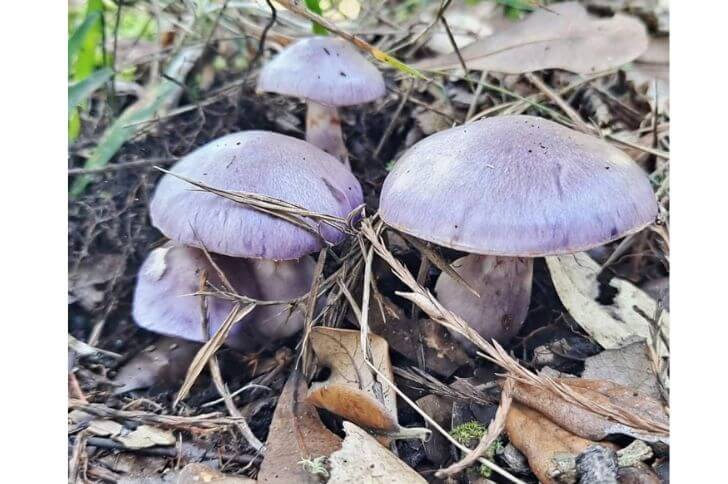
Wood blewit mushrooms are probably the most common edible mushrooms of San Diego. Scientifically known as Clitocybe nuda, they are an interesting type of purple fungi.
Identification:
The mushrooms have a distinct, deep purple color on their caps and stalks, making them easy to spot among other fungi. Wood blewits have a citrusy scent when held closely. These mushrooms are typically found growing in clusters near trees in wooded areas between late summer and early winter.
Wood blewits can be eaten, however it is important to properly cook before you eat them. Tastes yummy sauteed or in soups.
8. Oyster Mushrooms

Are there oyster mushrooms in San Diego? Yes, pearl oyster mushrooms can be found in the wild. Also, pink oyster and blue oyster mushrooms are locally cultivated and sold in stores and farmers markets.
Identification:
Oysters mushrooms are an edible fungi that can be found growing on trees, logs, or stumps in the woods. These mushrooms have a distinct look and flavor that make them easily identifiable from other types of mushrooms.
Oysters are saprotrophic, growing on dead aspens and beeches. Their name is due to their shape and texture resembling that of an oyster shell.
They have a white to grayish cap with a fan-shaped top and curved edges. The underside of the cap is densely covered with off-white gills and with no stalk. When young, they also have an anise smell which helps distinguish them from other types of mushrooms.
When it comes to cooking, there are different ways to prepare oyster mushrooms including tacos, burgers, salads and more.
Inedible San Diego Fungi
9. Pholiota Spumosa
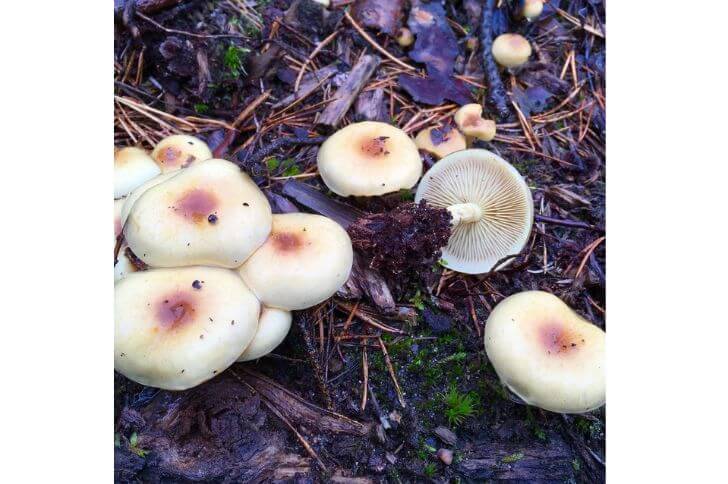
Pholiota spumosa is a type of California mushroom that pops out after heavy rainfall. Currently, its edibility is unknown.
Identification:
This species is identifiable by its yellow to orange-brown caps that are about 1-3 inches wide. Caps are hairy with inward curved edges. The underside consists of yellowish-buff, crowded adnate gills.
Pholiota spumosa’s stipe stands at about 3 inches for mature species. It has a narrow base and is covered with fibrils. They often form clusters and do not have a distinctive smell or taste.
10. Liver Bolete
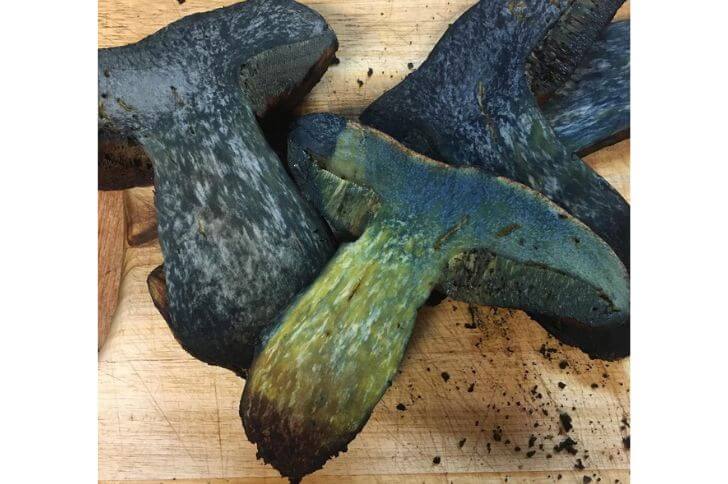
Common in Western North America, liver bolete mushrooms or Suillellus amygdalinus are ground mushrooms which occur in groups but can be found scattered.
Identification:
Commonly found between October and January in hardwood forests, these boletes have many lookalikes so you have to be keen when identifying them.
Liver boletes are large mushrooms with the caps ranging from 2.4-4.7 inches. You can identify younger species by the reddish dry caps. With age, the reddish tone changes to brownish. Also, the caps are incurved for young liver boletes, gradually decurving as they age.
Their thick stems are yellowish and covered with reddish fibrils. Can you eat liver boletes? No. When sliced, liver boletes have yellowish flesh that quickly stains blue. Researchers have discouraged the consumption of any blue-staining fungi.
11. Western Jack-o-Lantern
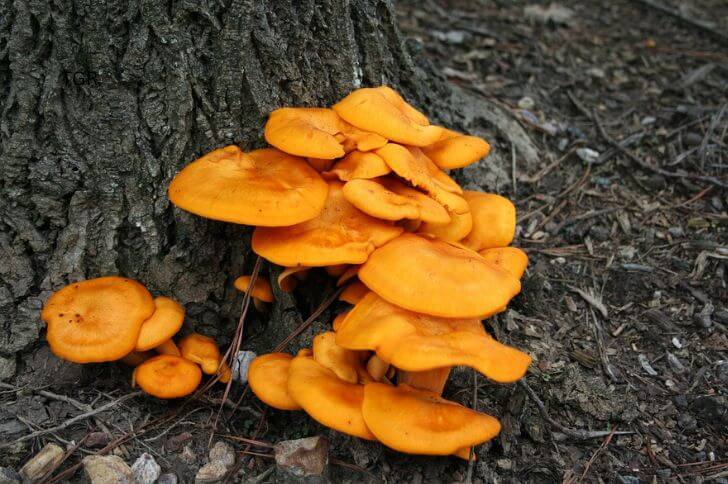
Western jack-o-lantern mushrooms are a species of fungus known for their bright orange glow. Found in the western United States, these mushrooms can be seen growing in clusters.
Identification:
To a novice forager western jack-o-lanterns look like chanterelles. But, they are not. There are telltale features that’ll help you avoid this mushroom.
In San Diego western jack-o-lanterns are found mostly on dry roots and stumps of eucalyptus during late summer and early fall months.The bright color makes them easy to spot.
Another identifying characteristic is the large soft cap. Jack-o-lanterns have large caps compared to their look-alikes, growing up to 7.1 inches in maturity. Due to overcrowding, the edges may appear wavy or make the mushroom appear funnel-shaped like chanterelles.
Under caps you’ll notice (true) olive colored gills. It also has a thick stalk that can reach up to 5.9 inches long. Lastly, like earlier we said they grow on stumps, fallen branches and dying roots while chanterelles grow on the ground.
FAQs
Is it illegal to forage in San Diego?
No. But if you want to forage in state parks within California one should have a permit. The permit is not transferable. Also, your car needs a valid mushroom card displayed on the dashboard.
What is the best month to go foraging in San Diego?
Most edible mushrooms grow after heavy rains. This means most mushrooms like sulphur shelfs, morels, boletes, and oysters will appear in mid-spring while a few such as wood blewits appear mid-summer to early winter.
In conclusion,San Diego has a wide variety of mushrooms that can be found in various habitats throughout the region. Whether you are looking for edible fungi or beautiful mushrooms to photograph, San Diego offers an abundance of mushroom species at any given time. With a little bit of knowledge and dedication, anyone can explore the world beneath their feet and discover these unique organisms.
Sources:
Hi There,
My name is Jenny. I’m the Chief Editor at Try Green Recipes and besides making yummy and healthy foods for my kids, grandkids, and friends. I’m new to the blogging world but I believe what I have to share is unique and will bring joy to your home. If you are adventurous and want try something tasty, let’s get started.

